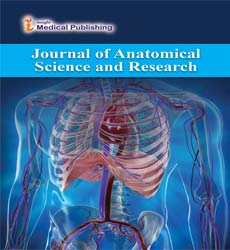Short Note on Pancreas
Harry Pacific Friedman*
Department of Endocrinology, University of Maryland, Maryland, United States
- *Corresponding Author:
- Harry Pacific Friedman
Department of Endocrinology,
University of Maryland,
Maryland,
United States
Tel: 22369981598;
E-mail: hapacf@gmail.com
Received Date: December 02, 2021; Accepted Date: December 16, 2021; Published Date: December 23, 2021
Citation: Friedman HP (2021) Short Note of Pancreas. J Anat Sci Res Vol.4 No.6:e002.
Description
The pancreas is a digestive organ situated in the abdomen. It is critical in transforming the food we eat into fuel for the body's cells. The pancreas has two primary functions: exocrine digestion and endocrine blood sugar regulation. The pancreas is located in the upper left abdomen, behind the stomach. Other organs around it include the small intestine, liver, and spleen. Its spongy and six to ten inches long, with the form of a flat pear or a fish stretched horizontally over the abdomen. The widest section, known as the pancreas head, is located in the middle of the belly. The pancreas's head is placed at the point where the stomach joins the first section of the small intestine. The pancreas distributes digestive enzymes into the contents of the intestine after the stomach dumps partially digested food into it. The neck or body of the pancreas is its core part. The tail is the slender end that extends to the left side. The pancreas is surrounded by many main blood arteries, including the superior mesenteric artery, superior mesenteric vein, portal vein, and celiac axis, which feed blood to the pancreas and other abdominal organs. Almost the entire pancreas is made up of exocrine tissue that generates pancreatic enzymes for digesting. The remaining tissue is made up of endocrine cells known as islets of Langerhans. These clusters of cells, which resemble grapes, release hormones that control blood sugar and pancreatic secretions. To digest the food, a healthy pancreas generates chemicals in proper quantities at the right times.
Exocrine glands in the pancreas produce enzymes that aid digestion. Trypsin and chymotrypsin are enzymes that digest proteins. Lipase is an enzyme that breaks down lipids and Amylase is an enzyme that digests carbohydrates when food enters the stomach, pancreatic fluids are discharged into a network of channels that eventually leads to the major pancreatic duct. The pancreatic duct meets the common bile duct to produce the ampulla of Vater, which is located in the duodenum, the first segment of the small intestine. The common bile duct originates in the liver and gallbladder and generates bile, which is a vital digestive juice. The pancreatic fluids and bile discharged into the duodenum aid in the digestion of lipids, carbs, and proteins.
The pancreas' endocrine component is made up of islet cells (islets of Langerhans) that produce and release essential hormones straight into the circulation. Insulin and glucagon which alter blood sugar levels are two of the most important pancreatic hormones. Maintaining normal blood sugar levels is critical for the proper functioning of critical organs such as the brain, liver, and kidneys.
Pancreatitis, precancerous diseases such as PanIN and IPMN, and pancreatic cancer are all examples of pancreatic disorders. Each condition has its own set of symptoms and necessitates its own set of therapies.
Pancreatitis is an inflammation of the pancr eas caused by an increase in pancreatic enzyme secretions, which begin to break down the organ itself. It might manifest as acute painful assaults that last a few days or as a chronic illness that worsens over time.
Pancreatic cancer
Pancreatic adenocarcinoma is the most prevalent kind of pancreatic cancer. It is an exocrine tumor that develops from the cells in the lining of the pancreatic duct. Endocrine tumors, a considerably less frequent kind, account for fewer than 5% of all pancreatic cancers and are also known as neuroendocrine or islet cell tumors.
Precursors to pancreatic cancer
Although the precise origin of pancreatic cancer is unknown, many recognized risk factors enhance the risk of developing the illness. Some of these risk factors include cigarette smoking, a family history of pancreatic cancer or hereditary cancer syndromes, and chronic pancreatitis. Furthermore, pancreatic lesions such as Intraductal Papillary Mucinous Neoplasms (IPMNs) and Pancreatic Intraepithelial Neoplasia (PanIN) are thought to be precursors of pancreatic cancer.
Open Access Journals
- Aquaculture & Veterinary Science
- Chemistry & Chemical Sciences
- Clinical Sciences
- Engineering
- General Science
- Genetics & Molecular Biology
- Health Care & Nursing
- Immunology & Microbiology
- Materials Science
- Mathematics & Physics
- Medical Sciences
- Neurology & Psychiatry
- Oncology & Cancer Science
- Pharmaceutical Sciences
